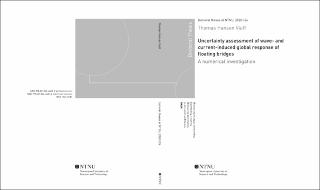| dc.contributor.author | Viuff, Thomas Hansen | |
| dc.date.accessioned | 2020-04-15T09:23:20Z | |
| dc.date.available | 2020-04-15T09:23:20Z | |
| dc.date.issued | 2020 | |
| dc.identifier.isbn | 978-82-326-4601-2 | |
| dc.identifier.issn | 1503-8181 | |
| dc.identifier.uri | https://hdl.handle.net/11250/2651104 | |
| dc.description.abstract | Floating pontoon bridge concepts have proven to be useful for crossing very deep and wide waters where conventional bridge types are not feasible, and different concepts have been built in several locations around the world within the last 70 years. Norway and the United States in particular have contributed to the capabilities of the technology and some of the most impressive floating pontoon bridge structures are currently located in those two countries, i.e. the Hood Canal Bridge in the United States and the Bergsøysund- and Nordhordland Bridges in Norway.
Today the Norwegian Public Roads Administration (NPRA) has proposed to establish several fixed links across the many wide and deep fjords in the western part of Norway and floating pontoon bridge concepts are among the proposed solutions. However, with the proposed concepts having unprecedented lengths of up to 5,000 m, the current understanding and technology related to floating bridges are pushed to their limits. Uncertainty in estimation of environmental design loads and the capabilities of existing numerical tools are some of the challenges considered for the new bridge structures and question fundamental pillars in the structural design.
The present thesis focuses on uncertainty assessment of the wave- and current-induced global response of curved floating pontoon bridges. The assessment includes investigation of the effect of uncertainties in design wave environments on the extreme response, and a comparison of two commonly used computer programs, i.e. Sima and OrcaFlex, when applied to floating bridge concepts. Furthermore, Sima is verified towards previous experiments of a generic floating pontoon bridge concept carried out in 1989 by Marintek (now SINTEF Ocean).
The findings suggest that, for the studied bridge concepts, the extreme response is only slightly affected by changes in the main wave direction for directions within +/- 15 degrees from beam sea and for changes in the spreading exponent within naturally occurring values, i.e. 2 and 10. Furthermore, the responses calculated with the two computer programs, Sima and OrcaFlex, are within 5-15% of each other, when applied to the Bjørnafjord phase 2 floating pontoon bridge concept, selected by the NPRA. Finally, Sima is verified towards previous experiments for a generic floating pontoon bridge concept with a length of roughly 830 m, with a comparison close to the inherent experimental uncertainties of 5-10%. This is valuable knowledge for any future experiments of the selected floating bridge concepts, since the extreme lengths of the bridges necessitate the use of hybrid tests, which utilize numerical tools in the experimental measurements. | en_US |
| dc.language.iso | eng | en_US |
| dc.publisher | NTNU | en_US |
| dc.relation.ispartofseries | Doctoral theses at NTNU;2020:126 | |
| dc.relation.haspart | Paper 1:
T. Viuff, B. J. Leira, X. Xiang, O. Øiseth,
"Effects of wave directionality on extreme response for a long end-anchored floating bridge",
Applied Ocean Research, vol. 90, pp. 101843, May 2019.
https://doi.org/10.1016/j.apor.2019.05.028
This is an open access article under the CC BY license | en_US |
| dc.relation.haspart | Paper 2: T. Viuff, X. Xiang, B. J. Leira and O. Øiseth, “Software-to-software comparison of end-anchored floating bridge global analysis”, Bridge Engineering, vol. 25(5), pp. 04020022, March 2020. doi:10.1061/(ASCE)BE.1943-5592.0001545. With permission from ASCE. This material may be downloaded for personal use only. Any other use requires prior permission of the American Society of Civil Engineers. This material may be found at https://ascelibrary.org/doi/10.1061/(ASCE)BE.1943-5592.0001545 | en_US |
| dc.relation.haspart | Paper 3: T. Viuff, X. Xiang, O. Øiseth and B. J. Leira, “Model uncertainty assessment for wave- and current-induced response of a curved floating pontoon bridge”, Applied Ocean Research. Under review. | en_US |
| dc.title | Uncertainty assessment of wave- and current-induced global response of floating bridges - A numerical investigation | en_US |
| dc.type | Doctoral thesis | en_US |
